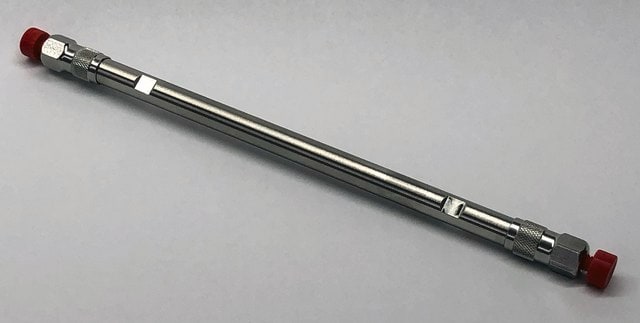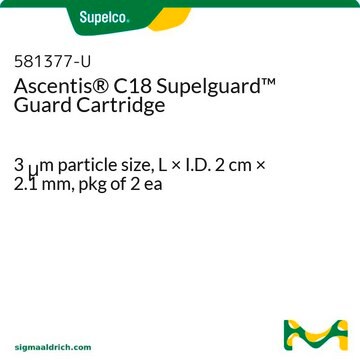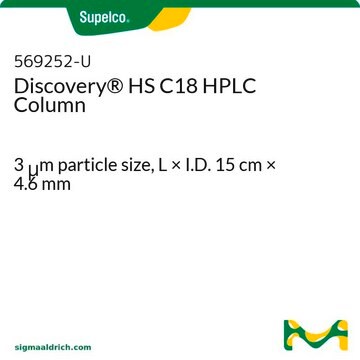581301-U
Ascentis® C18 (3 µm) HPLC Columns
L × I.D. 10 cm × 2.1 mm, HPLC Column
Synonym(s):
Ascentis RP18 HPLC Column
Sign Into View Organizational & Contract Pricing
Select a Size
All Photos(2)
Select a Size
Change View
About This Item
UNSPSC Code:
41115700
eCl@ss:
32110501
NACRES:
SB.52
Recommended Products
Product Name
Ascentis® C18 HPLC Column, 3 μm particle size, L × I.D. 10 cm × 2.1 mm
material
stainless steel column
Agency
suitable for USP L1 (Similar to Phenomenex Luna C18)
product line
Ascentis®
feature
endcapped
manufacturer/tradename
Ascentis®
packaging
1 ea of
extent of labeling
25% Carbon loading
parameter
≤70 °C temp. range
400 bar pressure (5801 psi)
technique(s)
HPLC: suitable
LC/MS: suitable
Looking for similar products? Visit Product Comparison Guide
Related Categories
General description
The Ascentis family of columns is the fourth generation of HPLC column technology from Supelco scientists. Ascentis columns are bonded on high purity, 100 Angstrom silica including 3, 5, and 10 micron particle size. Columns are designed for small molecule applications and are scalable from micro columns (1.0 mm I.D.) to preparative dimensions (50 mm I.D.). The family includes C18, C8, Phenyl, Si and embedded polar group phase, RP-Amide.
Ascentis C18 is an extremely stable and reliable first choice HPLC column that gives symmetric peak shape and excellent retention even for difficult compounds.
Ascentis C18 is an extremely stable and reliable first choice HPLC column that gives symmetric peak shape and excellent retention even for difficult compounds.
Application
- Identification of recombinant human insulin and biosynthetic insulin analogues by multiplexed targeted unlabeled mass spectrometry of proteotypic tryptic peptides.: This study employs the Ascentis® C18 HPLC column for the separation of proteotypic tryptic peptides, allowing the identification of human insulin and biosynthetic insulin analogues through multiplexed targeted unlabeled mass spectrometry. The method demonstrated high specificity and sensitivity, enhancing the accuracy of insulin analysis in pharmaceutical research (Qasem et al., 2019).
- Development and validation of a novel stability-indicating HPLC method for the simultaneous assay of betamethasone-17-valerate, fusidic acid, potassium sorbate, methylparaben, and propylparaben in a topical cream preparation.: Utilizing the Ascentis® C18 HPLC column, this research presents a novel stability-indicating method for the simultaneous assay of multiple compounds in a topical cream. The validated method offers robust stability assessment, critical for ensuring the quality and efficacy of pharmaceutical formulations (Byrne et al., 2014).
- HPLC-DAD and HPLC-ESI-MS/MS methods for metabolite profiling of propolis extracts.: This paper describes the use of the Ascentis® C18 HPLC column in HPLC-DAD and HPLC-ESI-MS/MS methods to profile metabolites in propolis extracts. The column′s performance in separating complex mixtures highlights its utility in natural product research and quality control (Pellati et al., 2011).
- Practical comparison of 2.7 microm fused-core silica particles and porous sub-2 microm particles for fast separations in pharmaceutical process development.: This study compares the performance of the Ascentis® C18 HPLC column with other chromatographic columns for fast separations in pharmaceutical process development. The Ascentis® column provided superior separation efficiency and speed, making it advantageous for high-throughput pharmaceutical analysis (Abrahim et al., 2010).
Features and Benefits
- Excellent retention
- Symmetric peak shape
- High reproducibility
- Complete LC-MS compatibility
Legal Information
Ascentis is a registered trademark of Merck KGaA, Darmstadt, Germany
Application
guard cartridge
Storage Class Code
11 - Combustible Solids
WGK
WGK 3
Flash Point(F)
Not applicable
Flash Point(C)
Not applicable
Choose from one of the most recent versions:
Already Own This Product?
Find documentation for the products that you have recently purchased in the Document Library.
Dipanjan Goswami et al.
Biomedical chromatography : BMC, 23(11), 1227-1241 (2009-07-14)
A LC-MS/MS method for plasma topiramate analysis is delineated involving least number of healthy volunteers. Topiramate and amlodipine internal standard (IS) were extracted by simple centrifuge-coupled solid-phase extraction and reverse-phase chromatographic separation was performed on an Ascentis C(18) column. Turbo-spray
Federica Pellati et al.
Journal of pharmaceutical and biomedical analysis, 55(5), 934-948 (2011-04-19)
In this study, the composition of polyphenols (phenolic acids and flavonoids) in propolis extracts was investigated by HPLC-DAD and HPLC-ESI-MS/MS by comparing the performance of ion trap and triple quadrupole mass analyzers. The analyses were carried out on an Ascentis
Federica Vacondio et al.
Journal of pharmaceutical and biomedical analysis, 46(1), 200-205 (2007-10-26)
A rapid, simple and sensitive liquid chromatography-mass spectrometry (LC-MS) method was developed and validated for the determination of the imidazole H(3) antagonist ROS203 in rat plasma, using the superior homologue ROS287 as internal standard. Analyses were performed on an Agilent
Federica Pellati et al.
Journal of chromatography. A, 1242, 43-58 (2012-05-09)
In this study, a detailed phytochemical characterization of Echinacea pallida (Nutt.) Nutt. root extracts and dietary supplements was carried out for the first time by developing advanced chromatographic techniques, based on HPLC with diode array (DAD) and electrospray ionization-mass spectrometry
Meiyun Shi et al.
Journal of chromatography. B, Analytical technologies in the biomedical and life sciences, 951-952, 129-134 (2014-02-22)
Aralia mandshrica is a well-known traditional Chinese medicine from Northeast China commonly used to treat digestive, circulatory and immune system disorders. Calenduloside E is one of its bioactive components currently under evaluation as a pure drug. In this study, a
Chromatograms
application for SPE, application for LC-MSOur team of scientists has experience in all areas of research including Life Science, Material Science, Chemical Synthesis, Chromatography, Analytical and many others.
Contact Technical Service







